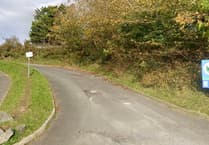Help protect our cliff-nesting birds
Lynne Houlston, National Park Authority ranger for the MOD Castlemartin Range, explains how we can help protect our cliff-nesting birds as we, residents and visitors, enjoy the Pembrokeshire Coast at this time of the year.
Spring has sprung - supposedly, and the birds are already starting to prepare for nesting. Guillemots, razorbills, chough, peregrine, fulmars and gulls are flocking to the cliffs squawking, squabbling, feeding and nesting.
The cliffs are vital for these birds, not least the chough (pictured), but they are also important for recreation; climbers too will be heading cliff-wards at this time.
The chough is one of the most enchanting members of the crow family and, thankfully, it is quite numerous all round the Pembrokeshire coast and on the offshore islands where its favourite nesting sites in inaccessible caves, cracks and crevices in the cliff face are abundant.
The uninitiated can mistake this black bird with its wheezing call for its first cousin the jackdaw, but close inspection reveals the difference, particularly when it is seen pecking the clifftop turf in search of soil-dwelling invertebrates like worms, beetles, ants, larvae and grubs. It even likes lichen and will also eat grain and berries on open ground.
Its pink, pointed curved beak and its bright orange legs, reveal its difference from the jackdaw with its straight, black bill and black legs. It is blacker, sleeker. glossier and more beautiful than the jackdaw. The call is different too, and an umistakeable distinguishing feature, for, unlike the jackdaw’s harsh ‘chack,’ the chough’s is a somewhat asthmatic wheezing cry, softer and less aggressive. Another distinguishing feature is its rather erratic, almost butterfly, flight, and it is a shyer bird than its cheeky jackdaw cousin, although just as gregarious. Wherever you are on the Pembrokeshire coast or on the islands, in places where the cliffs provide suitable nesting holes, you are likely to see a chough or two, and sometimes in autumn and winter a small flock on the clifftop sward or enjoying an exuberant aerobatic romp in a boisterous wind, using their long, squarish fingered wings for precise manouevring.
To prevent the birds from being disturbed during this significant time, climbing restrictions are put in place every year - most of these, especially in the south of the county, are marked by red concrete pots or notices.
Some birds, such as oystercatchers, nest low down in our bays and coves. It is important that kayakers are aware of these birds and do not cause any disturbance.
If you can hear birds squawking loudly and flying above your head - you need to move!
Leaflets and posters showing the location of the restrictions and listing the climbs restricted are available at the St. Govan’s, Stack Rocks, Stackpole Quay and Broad Haven South car parks.
Communications
Due to unreliable landline broadband across many areas of West Wales, scores of farmers, local businesses and even local authorities have, in frustration, felt obliged to turn to using an alternative, reliable and very cost effective communications system, made available thanks to an ambitious local internet broadband company.
Several major companies have done likewise, including Riverlea - very dependant upon good communications between their suppliers - after they realised that their existing system had been in place for several decades and was creaking heavily under the strain - computers were very slow and crashing daily when they tried to download data.
The long-promised superfast high speed internet was showing no signs of arriving in their area, so they turned to Carmarthen-based Bluewave Internet for help.
Bluewave Internet offers an alternative to the traditional ’phone line dependent broadband by installing a small transmitter in the local area which broadcasts a wireless signal much like a mobile phone network.
Nicola Jones, director of Riverlea, said: “As IT plays a crucial part in our day to day running of the business, we made a major decision to progress and move forward with our IT requirements. In doing so, we turned to Bluewave who showed a high level of commitment, knowledge and understanding of our business. Guiding us to an innovative way of providing high speed and stability for our internet connection, which is paramount linking our computer systems in all our branches.”
Ofcom, the telecoms regulator, has acknowledged that mobile coverage is particularly poor in most of the rural areas of West Wales and has recently reported that it is investigating a number of ways in which it could act to help tackle this problem.
Until May 4, it is consulting on whether the future 700 MHZ band spectrum due for release in the second half of 2019 should ensure better overall coverage.
In 2014, the four main mobile phone operators committed to 90 per cent landmass coverage by the end of 2017. Ofcom has now asked them to confirm they have met their targets and is changing the way it measures mobile coverage to reflect the fact that smart mobile phones receive more data and hence need stronger signals.
Ensuring consumer supplies
A measure of the confidence seen in some areas of the dairy industry came last week when it was announced that the Dairy Farmers of Canada organisation has received an investment of 2.2 million Canadian dollars from the government’s Growing Forward 2 Programme.
Additionally, the Canadian Dairy Commission launched the Workforce Development Initiative - a three-year, C$5m investment to support the attraction and education of a qualified workforce in the Canadian dairy industry.
The funds will assist DFC in rolling out two projects: an on-farm customer assurance program; and a national traceability system for the dairy sector.
The Growing Forward 2 AgriMarketing programme provides support to national associations for the development of assurance systems or standards, such as food safety, traceability and plant and animal health surveillance systems, and market attributes/quality standards.
The Workforce Development Initiative program is composed of four key funding programmes: a scholarship programme has been introduced for graduate students in fields related to the dairy industry; the career promotion programme will promote careers in the dairy industry; an education program will look to create government-certified, full-time educational programmes to train qualified staff to work in dairy plants; and a continuing education programme will create opportunities for continuing education for current dairy plant and farm staff.
Organisations eligible for funding include industry associations and learning institutions.
Alistair Johnston, chairman of CDC, said: “When we consulted representatives of the dairy industry, they were quite clear that one of their major challenges now and in the years to come, is to attract and retain qualified workers, especially in the cheese plants. We hope that this initiative will help attract young people into this exciting industry.”
The milk processing industry ships C$15.2m in products annually, and employs about 22,900 people in 471 plants.
The CDC helps design, implement, and administer policies and programs to support milk producers and processors. It is mandated to provide efficient milk producers with the opportunity to get a fair return on their labour and investment, and to ensure that Canadian consumers are provided with adequate supplies of dairy products.
Life’s like that!
There is a nine-year-old kid sitting at his desk and, all of a sudden, there is a puddle between his feet and the front of his pants are wet.
He thinks his heart is going to stop because he cannot possibly imagine how this has happened. It’s never happened before and he knows that, when the boys find out, he will never hear the end of it.
When the girls find out they will never speak to him again as long as he lives. The boy believes his heart is going to stop; he puts his head down and prays this prayer: “Dear God, this is an emergency! I need help now! Five minutes from now I’m dead meat.”
He looks up from his prayer and here comes the teacher and the look in her eyes says that he has been discovered.
As the teacher is walking towards him, a classmate named Susie is carrying a goldfish bowl that is filled with water. Susie trips in front of the teacher and, inexplicably, dumps the bowl of water in the boy’s lap.
The boy pretends to be angry but, all the while is saying to himself ‘Thank you Lord, Thank you Lord.’
Now, all of a sudden, instead of being the subject of ridicule, the boys is the object of sympathy. The teacher rushes him downstairs and gives him his gym shorts to put on while his pants dry out.
All the other children are on their hands and knees cleaning up around the desk. The sympathy is wonderful. But as life would have, the ridicule that should have been his has been transferred to someone else - Susie. She tries to help, but they tell her to get out “You’ve done enough trouble already.”
Finally, at the end of the day, as they are waiting for the bus, the boy walks over to Susie and whispers: “You did that on purpose didn’t you?”
Susie whispers back: “I wet my pants once too.”





Comments
This article has no comments yet. Be the first to leave a comment.